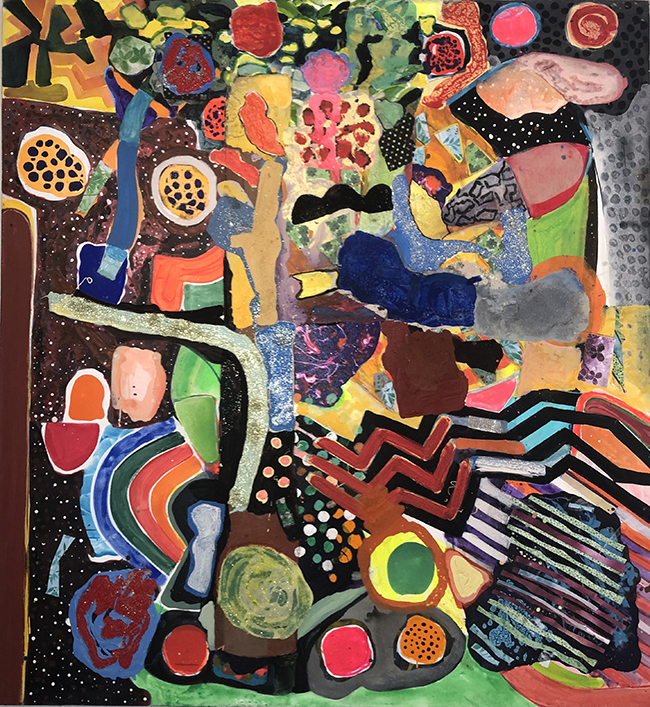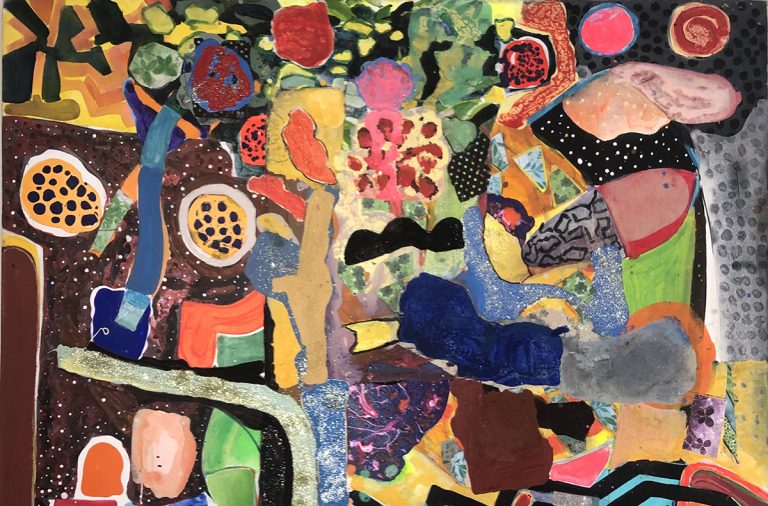Mitchell Rosenzweig’s art doesn’t shout. It doesn’t need to. It speaks with quiet force—the kind that comes from confidence, not volume. His abstract mixed media paintings are built, not thrown together. They carry the kind of structure you might miss at first, buried beneath brushstrokes, scraps of paper, and fragments of imagery. But it’s there. Layered like geological strata. Each layer isn’t just texture or color—it’s part of the painting’s backbone.

Rosenzweig doesn’t rely on spectacle. His paintings don’t hit you over the head. Instead, they draw you in. The longer you look, the more you realize they’re working on a different frequency. There’s chaos on the surface, sure—splatters, bursts of color, unexpected shifts. But underneath, there’s discipline. A sense of design. He’s figured out how to let two opposite impulses—mess and order—live side by side without one canceling the other out. That balance is what gives the work its staying power.
You see it clearly in a painting like Blue Dog.
Blue Dog isn’t just a title—it’s a hint. There is, in fact, a blue dog in the painting, though it doesn’t bark for your attention. It just… exists. Almost spectral. The image emerges from the tangle of colors and shapes like a memory. Around it, there’s a swarm of geometric forms—triangles, rectangles, stripes—each layered over or under something else. You get bright bursts of color. Deep reds. Lemon yellows. Rich ultramarines. Then, right when your eye gets comfortable, it hits a soft gray or an unexpected smear of black.
This piece wasn’t made in a rush. It took Rosenzweig four years. And you can feel that time in the work. It has that slow-brewed quality. Some marks seem fresh, like they were made yesterday. Others are half-buried, like something weathered and ancient. The painting becomes a sort of record—not of time passing in a neat line, but of time overlapping, pressing in on itself.
There are hints of the natural world—stars, horizon lines, maybe even the outline of a tree or mountain—but nothing’s clear-cut. Nothing stays in place long enough to be named. Instead, the painting moves. It shifts. One moment it feels cosmic. The next, intimate. It’s like flipping through pages of a dream you only half-remember.
What keeps Blue Dog from falling apart is Rosenzweig’s control over structure. You never get the sense that any piece of the painting is random. The weight of the dog balances against the geometry. The sharp lines counter the more chaotic brushwork. Even the placement of colors feels purposeful—like every tone was earned.
Rosenzweig is working in the language of mixed media, but he doesn’t treat materials like decoration. They’re part of the message. Every scrap of paper, every textured surface, every scribbled mark contributes to the architecture of the painting. These elements aren’t there just to impress—they’re there to support. The work is physical. It feels like it has heft.
And yet, despite all that, the painting never feels heavy. It moves. It has rhythm. It breathes. That’s part of the tension Rosenzweig creates—solidity without stiffness. Movement without chaos. Each decision is deliberate, but not overthought. That’s a tightrope, and Rosenzweig walks it well.
Blue Dog is one piece, but it speaks to his whole approach. He’s not chasing trends. He’s not trying to overwhelm the viewer. Instead, he’s building something that lasts. His work invites slow looking. It earns your time. Not through spectacle, but through depth.
Rosenzweig understands that a painting doesn’t have to be loud to hold its ground. It just has to be built right. Layer by layer. Line by line. Scrap by scrap. That’s how you make something that doesn’t just catch the eye—but stays with it.


